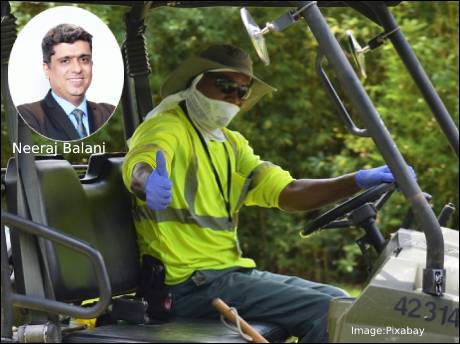
Neeraj Balani, Managing Director, International SOS, India, suggests how to build a safe, resilient and sustainable future for your workforce
January 20 2021: The safety of your workplace becomes a primary focus as lockdown measures relax. While no business can guarantee preventing the spread of infection, vital precautionary steps will minimise risks, fulfil your Duty of Care responsibilities and promote workforce resilience.
Whatever the circumstances, whether an office, a factory, a retail outlet or even an oil rig, preparation and real-time insights are a must for organisation to detect threats, mitigate risks, and provide swift treatment if needed. Organisations need to take into account local governmental guidelines and an assessment of what is necessary for a particular workforce, both from a logistical perspective and personal one. Failure to manage a safe return could result in a backwards step in productivity, in the fight against COVID-19, and could even result in costly prosecutions.
Your Organisation’s resilient workforce programme must include everything you need to safely manage your global teams while they work around the world. As a Business continuity head or a CHRO your prime responsibility is to prepare your people for layered threat environments, helps them to feel supported and productive, and provides them with assistance whenever they have a question, concern or crisis. Anytime, anywhere.
In my discussion with CXOs of various multinational organisations which we support on building return to workplace guidelines and put in medical and security safety measures for employees, we recommend a 5-pillar approach to be executed with the help of their existing IT platforms and a solid reporting and governance platform.
5-pillar approach
The first pillar is to ensure that organizations recognize the questions relevant to their businesses and build a customized strategy and plan for processes and protocols ensuring inputs from the changing external environment. Like what customizations are needed for head office v/s retail store v/s manufacturing unit v/s branch office?
The second pillar is providing for on ground medial facilities and support including mental wellness to your employees. This is a pandemic and the best person to guide you and your employees to comply in all situations is a medical expert. For example, access to a reliable doctor and hospital network is the biggest worry for your workforce, especially when they perform the role of a care giver to their dependents such as children and parents.
The third pillar is ensuring access to medical supplies such as PPE and test kits (as they become viable and available in India) for your workforce, especially when they live, commute or work in a densely populated environment.
The fourth pillar is that of a medically lead quality assurance. Once the lockdown is relaxed we forecast that processes laid down for social distancing, screening, health checks will tend to get diluted. Hence it is imperative that a medical expert audits them and reports the quality and effectiveness of the processes to the CEO as the trusted advisor on the organization resilience!
The final pillar of-course is that of reporting and governance. Every organization needs to build in resilience KPI’s which need to be monitored and reported so that corrective action and measures are timely. It will be important for all organizations to leverage their IT platforms to set the KPI’s and monitor their progress in an efficient manner.
We believe that the above approach will ensure organizations build resilience by ensuring they safeguard their employee wellbeing, boost their cost efficiencies and help protect the communities where they thrive. Our dream to reboot the “Make in India” dream starts with a “Healthy India”. The Indian business community will play a leading role in the coming days to move towards a “Healthy India” and reduce the COVID-19 aftermath.